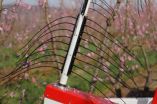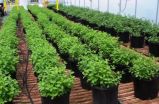(Press-News.org) RICHLAND, Wash. – In some cases, soot – the fine, black carbon silt that is released from stoves, cars and manufacturing plants – can pack more of a climatic punch than greenhouse gases, according to a paper published in the journal Atmospheric Chemistry and Physics.
Researchers at the Department of Energy's Pacific Northwest National Laboratory, the University of Michigan and NOAA found that soot landing on snow on the massive Tibetan Plateau can do more to alter snowmelt and monsoon weather patterns in Asia than carbon dioxide and soot in the air. Soot on snow causes the plateau's annual glacial melt to happen sooner each year, causing farmers below it to have less water for their crops in the summer. In a domino effect, the melting then prods two of the region's monsoon systems to become stronger over India and China.
"On the global scale, greenhouse gases like carbon dioxide cause the most concern related to climate change," said Yun Qian, the paper's lead author and an atmospheric scientist at PNNL. "But our research shows that in some places like the Tibetan Plateau, soot can do more damage."
Roof of the Earth
Qian and his colleagues focused their research on the Tibetan Plateau, a giant outcropping of land between China and India that's nicknamed the "Roof of the Earth." About five times the size of Texas and as much as 5 miles high in places, the Tibetan Plateau greatly influences the Asia's weather, including the annual deluge of rain and strong winds that come with monsoons. It's also home to the largest volume of ice outside of the north and south poles. Glaciers and snow on the plateau grow and melt as seasons change, providing runoff that feeds most of the region's major rivers, including the Yangtze in China and the Ganges in India.
Soot has increasingly dirtied the Tibetan Plateau's winter-white surfaces in the past two decades. A byproduct of the region's rapid growth in industry and agriculture, soot leaves smokestacks and burning fields in developing Asian countries before it floats into the sky, where winds carry it toward the plateau. Soot is dark and absorbs far more heat from sunlight than pristine white snow. Soot's ability to soak up more solar rays causes the snow it lands on to melt faster. The Tibetan Plateau also receives more direct sunlight than the distant north and south poles, meaning soot's snow-melting powers are be more pronounced on the plateau.
To find out how much soot is affecting the Tibetan Plateau's region, Qian and colleagues used a global climate computer model, the Community Atmosphere Model. The model allowed them to examine a mixture of possible scenarios, including if soot sat on the Tibetan Plateau's snow, if soot was floating in the air above the plateau and if increased carbon dioxide was in the air as a result of industrialization.
More heat, melting
The model's calculations showed that the average air temperature immediately above the plateau increased when all the scenarios were combined. Alone, both soot on snow and carbon dioxide increased temperatures about 2 degrees Fahrenheit. But while carbon dioxide increased temperatures fairly evenly throughout the region, including the ocean, soot on snow only significantly heated up the Tibetan Plateau and north Asia. Researchers concluded that soot on snow can increase the temperature differences between air over land and air over the ocean, which drive monsoons.
Soot on snow also stood out when the model investigated water runoff. Smaller changes were observed when just carbon dioxide or soot in the air were examined, but soot on snow by itself increased runoff substantially during the late winter and early spring and then decreased it during the late spring and early summer. With all three scenarios combined, the runoff increased by 0.44 millimeters (or nearly two-one hundredths of an inch) daily between February and April and then decreased by 0.57 millimeters daily between May and July. These changes provide more water in the winter, when it's not particularly useful to farmers, but less in the summer when it's needed to grow crops.
The researchers reasoned that soot on snow is more efficient in melting the plateau's snowpack because of its close proximity to the snow. Like a warm blanket covering the plateau, soot on snow can almost immediately warm and melt the snow beneath it. But carbon dioxide and soot in the atmosphere have to transfer the heat they absorb way down to the plateau below, with some heat inevitably being lost.
Nature's heat pump
Before this research, scientists knew that the Tibetan Plateau acted like a natural heat pump for the region's weather. The plateau reaches 5 miles high in some places, allowing the air above it to be warmer than other air at the same elevation. The warm air strengthens air circulation around the plateau and causes the iconic, drenching monsoons that move through the region every year.
But with soot on snow causing more snowmelt on the plateau, the plateau is increasingly bare. Less snow covering to reflect solar heat means the Tibetan Plateau is absorbing more sunlight, which the researchers hypothesized was causing the atmosphere above the plateau to warm up even more. They used climate models to find out of this affects the area's monsoons.
Stronger monsoons
The surface temperature above the plateau increased by more than 2 degrees Fahrenheit in May due to soot on snow alone. The researchers found that this warmer air above the plateau rises and air is drawn from India to replace it. In turn, moist air hanging above Arabian Sea and Indian Ocean blows in over India. Known as the South Asian Monsoon system, this southwest-northeast flow also brings in more soot from India to the Tibetan Plateau that perpetuates the cycle. As a result, the researchers found that the South Asian Monsoon system is starting earlier and bringing more rain to central and Northern India in May than it would without soot on the plateau's snow.
The soot-on-snow effect lingers throughout the summer and causes another weather shift in the East Asian Monsoon system over China. By July, much of the plateau's snow has already melted. The plateau's bare soil is warmer and further heats the plateau's air. Coupled with cool ocean air nearby, the plateau's heat strengthens the East Asian Monsoon. The models showed that rain increases 1 to 3 millimeters per day over southern China and the South China Sea. The strengthened monsoon advances to northern China, which also receives more rain than it would otherwise, while the rains mostly skip central East China, including the Yangtze River Basin.
More work needs to be done to refine these findings, however. Qian and his co-authors noted that existing global climate models don't allow for the close-up, detailed resolution needed to accurately portray the Tibetan Plateau's many varying peaks. The model's coarse resolution likely resulted in the plateaus' snowpack being overestimated, meaning the researchers' results represent the maximum amount that soot on snow could potentially impact hydrological and weather systems in the region.
Future research could also factor in dust, which blows throughout Asia with the wind. While soot is believed to have a larger impact on snowmelt than dust per unit mass, the region likely has more total dust than soot. However, dust is more challenging to represent in models, since its sources can't be as easily measured as the polluting smokestacks and burning fields that cause soot.
"The Tibetan Plateau is an amazing, dynamic place where many things come together to develop large climate systems," Qian said. "Our research indicates that soot on snow can be a large player in the region's climate, but it's not the only factor. Many other elements need to be studies before we can say for sure what is the leading cause of snowmelt – which also contributes to retreating glaciers – on the plateau."
###This research was funded by DOE's Office of Science.
REFERENCE: Yun Qian, Mark G. Flanner, L. Ruby Leung, Weiguo Wang. Sensitivity studies on the impacts of Tibetan Plateau snowpack pollution on the Asian hydrological cycle and monsoon climate. Atmospheric Chemistry and Physics. Published online March 2, 2010. http://www.atmos-chem-phys.net/11/1929/2011/acp-11-1929-2011.html
Soot packs a punch on Tibetan Plateau's climate
Polluted snow causes early runoff, stronger monsoons in Asia
2011-03-04
ELSE PRESS RELEASES FROM THIS DATE:
"Wealth Masters International" Announces Their March Consultant of the Month, Robert Bob Chappell, Owner of Home Based Company, LLC
2011-03-04
Wealth Masters International March's Consultant of the Month: Bob Chappell of Home Based Company, LLC
On the first of March, the phone rings and I hear "Bob, it's Karl Bessey here. I just wanted to let you know that you have been chosen 'WMI Consultant of the Month.'"
My initial thought was "Wow... me? But there are so many more deserving people!"
Let me say that I am completely humbled and honored to receive this call from Karl.
I am so grateful that I found Wealth Masters International (Kip and Karl's Dream) through the three points of Wealth, Health and Wisdom ...
String blossom thinner proves effective across stages of bloom development
2011-03-04
BIGLERVILLE, PA—Blossom or fruitlet thinning is a labor-intensive part of commercial peach and nectarine production. The use of mechanical string blossom thinners has been shown to reduce labor requirements and improve fruit size in peach crops, but stone fruit producers have needed more information about the range of thinning times. New research from Tara Auxt Baugher and colleagues from The Pennsylvania State University and Penn State Cooperative Extension gives producers sought-after data about optimum thinning times.
Baugher said that, prior to this study on bloom ...
APS-Hoods Announces Turnkey Hood Installation Training in Las Vegas, Nevada
2011-03-04
American Professional Services (APS) recently announced that it is offering a commercial hood installation training program in the Los Vegas, Nevada area. The training will include how to install HVAC (Heating, Ventilating, and Air Conditioning) and fire suppression systems for businesses currently involved in restaurant construction, and for businesses running commercial kitchens needing an upgrade.
With headquarters in Denver, Colorado, APS specializes in commercial hood sales and professional cleaning services for commercial exhaust hood systems throughout the country.
When ...
Former Federal Reserve Chairman Alan Greenspan speaks out on the costs of government activism
2011-03-04
NEW YORK—March 3, 2011 — In an article to be published in the forthcoming issue of International Finance, Dr. Alan Greenspan, former chairman of the Federal Reserve, issues a major analysis of the U.S. government's economic recovery and reform efforts since the collapse of Lehman Brothers in September 2008.
Greenspan calculates that long-term fixed corporate investment "is now at levels, relative to cash flow, that we have not experienced since 1940." This shortfall, he explains, accounts for much of the tepid recovery and current abnormally high levels of unemployment. ...
'David and Goliath' viruses shed light on the origin of jumping genes: UBC study
2011-03-04
University of British Columbia researchers have identified a small virus that attacks another virus more than 100 times its own size, rescuing the infected zooplankton from certain death. The discovery provides clues to the evolutionary origin of some jumping genes found in other organisms.
The study, by UBC marine microbiologist Curtis Suttle and PhD student Matthias Fischer, is published online today in Science Express. It describes the marine virus Mavirus and its interaction with marine zooplankton Cafeteria roenbergenesis and CroV, the world's largest marine virus.
"It's ...
Bieber's Golden Locks Bought by GoldenPalace.com for Over $40,000
2011-03-04
Following a week of intense bidding, the auction for Justin Bieber's hair closed today with a final winning bid from GoldenPalace.com. The popular online casino spent $40,668.00 to lock down the teen singing phenom's famous locks with all proceeds going to support The Gentle Barn Foundation.
The idea for the auction began when The Biebs paid a surprise visit to Ellen DeGeneres during the taping of her show in February. The 53-year-old talk show host had recently tweeted that she wanted a lock of Bieber's hair for her birthday. Never one to disappoint a belieber, Justin ...
Chicken litter provides organic alternative to synthetic fertilizers
2011-03-04
CRYSTAL SPRINGS, MS—Recent movements aimed at managing environmental impacts of agriculture have spurred interest in the development and use of organic and natural fertilizers for commercial applications. Many organic fertilizers are byproducts of livestock, fish, food, and other processing industries. In Mississippi, where the poultry industry produces more than 730 million broiler chickens each year, and annual chicken litter production is estimated at more than 730,000 tons, there is a naturally abundant supply of chicken litter available for fertilizer.
New research ...
Using wastewater to enhance mint production
2011-03-04
SOUTH VERONA, MS—When essential oils are extracted from plants through the process of steam distillation, wastewater is produced and subsequently released into rivers and streams. Finding new uses for these unused by-products could benefit essential oil crop growers and processors as well as the environment. A team of researchers has found that the residual distillation water of some aromatic plant species has a beneficial effect on yields and can increase essential oil content of peppermint and spearmint crops.
Peppermint and spearmint are commercially produced for their ...
Researchers find possible new treatment strategies for pancreatic cancer
2011-03-04
Athens, Ga. – New University of Georgia research has identified a protein that can be modified to improve the effectiveness of one of the most common drugs used to treat pancreatic cancer.
The research, published in the March edition of the journal Cancer Research, found that a cell-surface protein called CNT1, which transports cancer-killing drugs into tumor cells, was reduced in function in two thirds of pancreatic tumors. By improving the function of CNT1, the researchers increased the effectiveness of the cancer-killing drugs in pancreatic tumor cells derived from ...
Feet first? Old mitochondria might be responsible for neuropathy in the extremities
2011-03-04
The burning, tingling pain of neuropathy may affect feet and hands before other body parts because the powerhouses of nerve cells that supply the extremities age and become dysfunctional as they complete the long journey to these areas, Johns Hopkins scientists suggest in a new study. The finding may eventually lead to new ways to fight neuropathy, a condition that often accompanies other diseases including HIV/AIDS, diabetes and circulatory disorders.
Neuropathies tend to hit the feet first, then travel up the legs. As they reach the knees, they often start affecting ...
LAST 30 PRESS RELEASES:
Press registration is now open for the 2026 ACMG Annual Clinical Genetics Meeting
Understanding sex-based differences and the role of bone morphogenetic protein signaling in Alzheimer’s disease
Breakthrough in thin-film electrolytes pushes solid oxide fuel cells forward
Clues from the past reveal the West Antarctic Ice Sheet’s vulnerability to warming
Collaborative study uncovers unknown causes of blindness
Inflammatory immune cells predict survival, relapse in multiple myeloma
New test shows which antibiotics actually work
Most Alzheimer’s cases linked to variants in a single gene
Finding the genome's blind spot
The secret room a giant virus creates inside its host amoeba
World’s vast plant knowledge not being fully exploited to tackle biodiversity and climate challenges, warn researchers
New study explains the link between long-term diabetes and vascular damage
Ocean temperatures reached another record high in 2025
Dynamically reconfigurable topological routing in nonlinear photonic systems
Crystallographic engineering enables fast low‑temperature ion transport of TiNb2O7 for cold‑region lithium‑ion batteries
Ultrafast sulfur redox dynamics enabled by a PPy@N‑TiO2 Z‑scheme heterojunction photoelectrode for photo‑assisted lithium–sulfur batteries
Optimized biochar use could cut China’s cropland nitrous oxide emissions by up to half
Neural progesterone receptors link ovulation and sexual receptivity in medaka
A new Japanese study investigates how tariff policies influence long-run economic growth
Mental trauma succeeds 1 in 7 dog related injuries, claims data suggest
Breastfeeding may lower mums’ later life depression/anxiety risks for up to 10 years after pregnancy
Study finds more than a quarter of adults worldwide could benefit from GLP-1 medications for weight loss
Hobbies don’t just improve personal lives, they can boost workplace creativity too
Study shows federal safety metric inappropriately penalizes hospitals for lifesaving stroke procedures
Improving sleep isn’t enough: researchers highlight daytime function as key to assessing insomnia treatments
Rice Brain Institute awards first seed grants to jump-start collaborative brain health research
Personalizing cancer treatments significantly improve outcome success
UW researchers analyzed which anthologized writers and books get checked out the most from Seattle Public Library
Study finds food waste compost less effective than potting mix alone
UCLA receives $7.3 million for wide-ranging cannabis research
[Press-News.org] Soot packs a punch on Tibetan Plateau's climatePolluted snow causes early runoff, stronger monsoons in Asia



